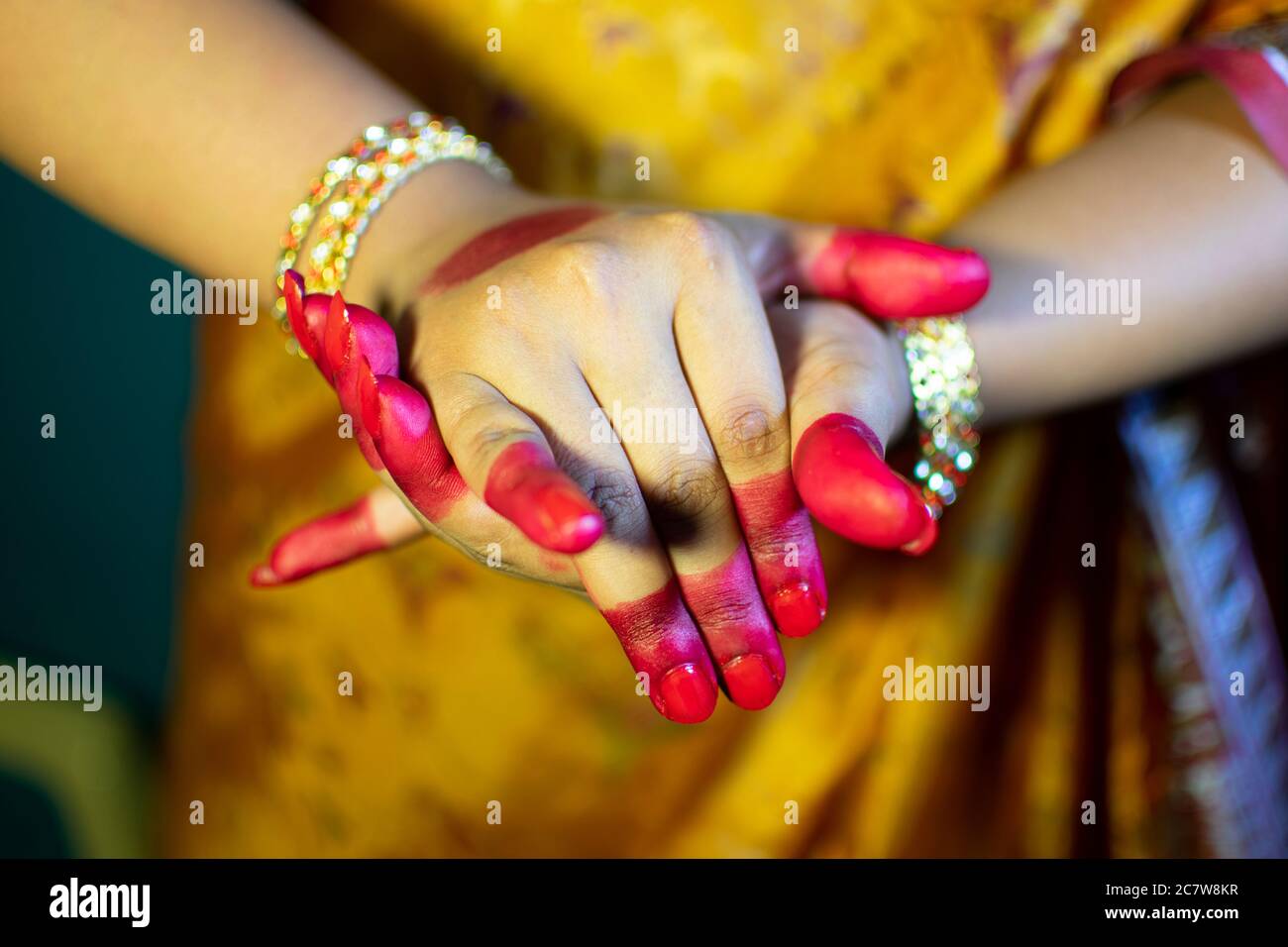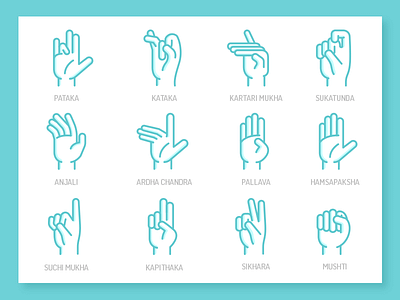Overview:
Mudras have been used in Indian theater and dance performance for centuries and have become a part of a larger culture of gestures through time. The process of the mudra employs the body to explain and perform concepts in an easy to understand way, that is available to everyone in an audience.
History of the Mudra
There are many different types of Mudras and uses for them in Indian culture. Mudras can be classified as a single-hand mudra, a joint-hand mudra, or a dance mudra that uses the entire body. There are also many different uses for mudras such as religious use, health use, and dance and performance use (Nair, n.d.).
Natyashastra
How to tell a story using hand gestures.www.esplanade.com/discover-and-learn/insight/secret-language-of-hands. In Bharatanatyam, the Classical Dance of India, approximately fifty-five root mudras (hand/finger gestures) are used to clearly communicate specific ideas, events, actions, or creatures in which thirty-two require only one hand, and are classified as `Asamyukta Hasta', along with twenty-three other primary mudras which require both hands and are classified as 'Samyukta Hasta. According to Bharata Muni, considered the founder of Indian aesthetics, there are 13 samyukta mudras (made with two hands) and 24 asamyukta mudras (made with one hand). Bharata Muni is quite categorical about this numerical division in the Natyashastra.
The origin of Indian theater is told about in the “Natyashastra” which translates to “The Drama Manual.” According to the manual, the art form of theater was created by the God Brahma. At the time, there were four Vedas, which are old scriptural texts in India. Brahma created the fifth Veda so that all could understand it. This turned into the Natya Veda. This was then used in forms of dance. The Natyashastra also created the idea of the Rasa and Bhava. The Bhava refers to the emotion that the dancer or actor portrays in their performance whereas the Rasa refers to how the Bhava makes the audience feel. The Rasa is the emotion that the audience obtains as a reflection of the Bhava. These became basics for performance in Indian culture and led the way for mudras to become part of the performance (Bharata and His Natyashastra, 2018).
Mudra is Sanskrit for “seal” or “mark.” This process actually has origins in Buddhist and Hindu religious practices as well as in the Natyashastra. Mudras are commonly used in meditation, devotional practices, and yoga. It is thought that performing mudras has a greater connection. They allow one to connect with different areas of their health and spiritual being. A theory of how the mudras came into the religious context is actually that they were used as a point of concentration during the chanting of the Vedas (scriptural texts) like the Vedas that were pointed out in the reference of the Natyashastra. Eventually, the mudras began to be used in ritual dances and performances as a way to portray the gods and to explain feelings or happenings. They also were thought to connect people and performers to a greater truth. They were able to unlock spiritual knowing and sentiments that other forms of prayer and worship had not yet done so. (Mudra, 2019).
Bharatanatyam
This is one of the seven classic styles of Indian dance and is one of the ways that we see mudras most commonly performed today. It is the oldest of the dance forms and the most widely performed. It has its origins in religion as well, as it was formed in the temples of Tamil Nadu for worship. However, over the last century, it has been updated for the use of the stage. Most commonly, the performance of the Mudra is used in dance numbers like in Video 1 below. These dance numbers are often Bharatanatyam. It combines facial expressions with quick movements and bodily gestures to add to what is seen in the performance. Of course, there are many performances of Bharatanatyam outside of the theater, but when the two are combined it is used as an interlude of sorts to re-explain the story in a new way to the audience (About Bharatanatyam, n.d.).
Yoga
As mentioned before, mudras are commonly used in yoga, rituals, and self-care today. Most of the mudras used in yoga are Hasta Mudras, or hand mudras. It is said that the use of them “directs the flow of energy into the body and help to stimulate the brain” (Madani, 1970). In yoga, the five fingers all have a specific connection. The thumb is fire; the pointer finger is air; the middle finger is space; the ring finger is earth; the pinky is water. These are used to ground the basis of certain mudras. An example of a common mudra used in yoga is thePrithvi Mudra. This is done by connecting the tip of the ring finger to the thumb and is often seen during times of meditation. It is said that this mudra lessens fatigue, balances the elements in the body, heightens self-confidence, and opens the mind. The figure below also shows and describes more mudras that are often used in self-care and yoga practices (Madani, 1970).
Mudras as a Gestural Language
Mudras were eventually used not just in rituals or as a connection with the body, but to tell stories. When Sanskrit was being used as the predominant written language of the culture, there were many people who were not actually able to read it. As a way to bypass the issue of illiteracy in Sanskrit, the gestural language was formed. Many of the mudras have multiple meanings that depend on the context of the story and are meant to be decoded by the viewer. Either way, the gestures made it easier to tell stories and have been added into Indian Theater performances as well as Indian dance, such as Bharatanatyam. In some dance performances, mudras are used for both the purpose of emotion and to tell stories. In the video below, many common gestural mudras that would often come up in stories are explained and shown (The Secret Language of Hands, n.d.).
An interesting point to note about the mudras in the video is how they can be very specific. For example, during the time of 0:30 – 1:15 in the video, all of the mudras being shown are about flags. Pataaka is a flag. Tripataaka is a flag with three colors. Ardha pataaka is half of a flag. The changes in these three start out small, but then by the time the Ardha pataaka is formed, the gesture looks to be very different from where it started, yet it is still related (Kalavenue, 2013).
This video is also about Asamyuta Hastas specifically. That means one handed gestures or mudras instead of two handed or full body mudras. The narrative nature is more noticeably present in the one-handed hastas over the ones that use more of the body. The greater use of the body is often for the display of emotion to the audience rather than to just describe something with a simple gesture such as the Asamyuta Hastas (Kalavenue, 2013).
Mudras In the Theater
Why does the use of the mudra matter in the theater? The mudra has now become integrated into Indian performance. In fact, many cultures have developed a gesture form similar to the mudra in their own performances. The use of gestures, whether they be full body, two hands, or single handed Hastas, narrates a part of the story and evokes certain emotions in the audience. In Indian theater especially, the grounding from the Natyashastra and religious practices gives mudras an untouchable place in the performance. It is just as much a part of what is happening on stage as any dance number, song, costume, or act.
What does this mean?
If one has not noticed through reading this, there seem to be many variations as to where the mudras actually came from and what constitutes them. Throughout my research, I had come across sources that tried to define how many mudras there were, what they meant and how to go about them. For example, a source said that the Natyashastra laid out a specific 66 mudras among its pages. However, looking at the yoga, or ritualistic mudras, these seem to be of an entirely different sort. On one end, these mudras are used to constitute emotions; on the other, they portray certain objects; somewhere in between, they can be used for healing. This not only leaves one questioning of course what the truth is in the somewhat muddled origins of mudras, but what exactly these bodily movements can mean for us.
.jpg)
In order for there to be so many variations on the same idea, somewhere along the way, it must have been agreed upon that mudras are an important factor in everyday life and performance. People likely came upon a realization of the ability of the human body to portray a multitude of concepts. There is so much that can be added to a performance by being fully engaged not just intellectually, but physically as well. The re-introduction and creation of multiple kinds of mudras throughout Indian culture shows that.
The purpose of the body in performance is ever growing and seemingly endless. To what end or what origin exactly may be foreseeably still in question. Nevertheless, there is no questioning that gestural practices like the use of mudras will continually have their place in theater and the practice of living in itself.
Works Cited:

Figure 1:
Lally, Brendan. Sitara Thobani Odissi classical dance mudra India. 10 February 2011. Wikimedia Commons. https://commons.wikimedia.org/wiki/File:Sitara_Thobani_Odissi_classical_dance_mudra_India_(19).jpg. Accessed 25 March 2019. Licensed under CC BY 2.0
Figure 2:
Dan, Mirahorian. Mudra 456. 8 January 2008. Flickr. https://flic.kr/p/4jrC91. Accessed 25 March 2019. Licensed under CC BY-ND 2.0

Video 1:
IndianRaga. “Shiva Shambho: Most Watched Bharatanatyam Dance | Best of Indian Classical Dance.” YouTube, 15 Sept. 2017, http://youtu.be/JWhA3ldZcyY.

Video 2:
Kalavenue. “Bharatanatyam – Learn Asamyuta Hasta [HD] (Video Lesson for Beginners).” YouTube, 7 July 2013, youtu.be/Y_vUCoufnws.
“About Bharatanatyam.” Sadhana Dance Theater, www.sadhanadancetheater.com/about-bharata-natyam. Accessed 5 April 2019.

“Bharata and His Natyashastra |.” Asian Traditional Theatre & Dance, 22 Feb. 2018, disco.teak.fi/asia/bharata-and-his-natyashastra/.
Gerould, Daniel. Theatre, Theory, Theatre. Applause, 2003.
Madani, Linda. “23 Sep The Meaning of Hasta (Hand) Mudras.” Intuitive Flow, 23 Sept. 1970, www.intuitiveflow.com/the-magic-of-the-hand-mudras/.
“Mudra.” Mudra – New World Encyclopedia, www.newworldencyclopedia.org/entry/Mudra. Accessed 5 April 2019.
Nair, Sreenath. “Mudra: Choreography in hands.” :: Body, Space & Technology Journal:: http://people.brunel.ac.uk/bst/vol1102/sreenathnair/home.html.
Bharatanatyam Mudras In Order
“The Secret Language of Hands.” Esplanade.com, www.esplanade.com/discover-and-learn/insight/secret-language-of-hands.